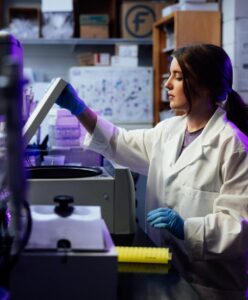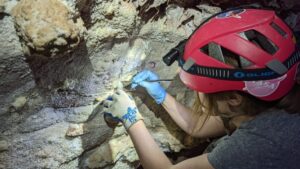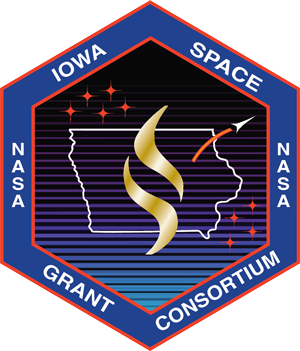 Moonmilk is a white substance mainly composed of calcium carbonate (CaCO3) that is often found in limestone caves. It is one of many mineral composites in Wind Cave National Park South Dakota and is thought to be formed by microbial activity. Some of the evidence supporting this hypothesis lies in the association of metabolically active microorganisms in moonmilk such as Macromonas bipunctata, a bacterium first discovered in caves over a hundred years ago. More recently, there is evidence that dry versus wet moonmilk harbor different bacterial communities (Shanae et al., 2020). We have collected our own samples of moonmilk from different areas within Wind Cave using sterile supplies to avoid cross-contamination.
Moonmilk is a white substance mainly composed of calcium carbonate (CaCO3) that is often found in limestone caves. It is one of many mineral composites in Wind Cave National Park South Dakota and is thought to be formed by microbial activity. Some of the evidence supporting this hypothesis lies in the association of metabolically active microorganisms in moonmilk such as Macromonas bipunctata, a bacterium first discovered in caves over a hundred years ago. More recently, there is evidence that dry versus wet moonmilk harbor different bacterial communities (Shanae et al., 2020). We have collected our own samples of moonmilk from different areas within Wind Cave using sterile supplies to avoid cross-contamination.  Each site had varying degrees of human exposure, from public tour routes to caverns only occasionally visited by park rangers. By extracting environmental DNA from these samples, we will then be able to measure microbial diversity. The resulting data set will allow us to estimate how much of the human microbiome transfers to moonmilk and whether there is a correlation between microbial diversity and the level of hydration in Wind Cave moonmilk. DNA will be extracted using the Qiagen PowerSoil Pro DNA Extraction kit followed by 16S rDNA PCR amplification and clone library construction to identify microbes. The results of this study will not only offer insights into the composition of microbial species in moonmilk, as well as their role in its formation, but will add to the larger genetic map of Wind Cave being constructed by the other students on my research team.
Each site had varying degrees of human exposure, from public tour routes to caverns only occasionally visited by park rangers. By extracting environmental DNA from these samples, we will then be able to measure microbial diversity. The resulting data set will allow us to estimate how much of the human microbiome transfers to moonmilk and whether there is a correlation between microbial diversity and the level of hydration in Wind Cave moonmilk. DNA will be extracted using the Qiagen PowerSoil Pro DNA Extraction kit followed by 16S rDNA PCR amplification and clone library construction to identify microbes. The results of this study will not only offer insights into the composition of microbial species in moonmilk, as well as their role in its formation, but will add to the larger genetic map of Wind Cave being constructed by the other students on my research team.
Emma Pellegrino – University of Northern Iowa
Student: Emma Pellegrino, Undergraduate Student in Biology and Biochemistry, University of Northern Iowa
Research Mentor: Dr. Marek Sliwinski

Exploring Microbial Composition of Moonmilk in Wind Cave National Park
2022-2023, Undergraduate
